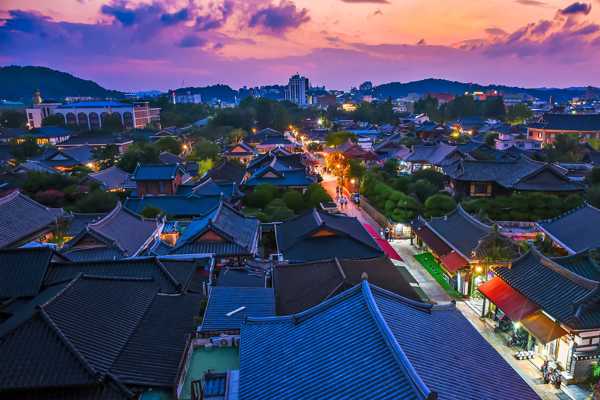The best local dishes from Jeonju solidify the city’s reputation as the food capital of South Korea. Thanks to its impressive culinary pedigree, the Jeonbuk city was selected as the first South Korean UNESCO City of Gastronomy in 2012. Expect lots of fresh ingredients in many traditional dishes like bibimbap (mixed rice bowl) and memil naengmyeon (chilled buckwheat noodles).
In addition to the wide assortment of classic Korean fare, you’ll find lots of contemporary food choices, too. Join us in exploring South Korea’s food capital as we delve into the best local dishes from Jeonju.
- 1
Jeonju bibimbap
Jeonju-style mixed rice bowls

- Makanan
Mention Jeonju to any local and bibimbap (mixed rice bowl) usually comes to mind. Bibimbap has become so synonymous with the Jeollabukdo capital that the city hosts a Bibimbap Festival every year in October.
Bibimbap usually consists of piping hot white rice, beansprouts, steamed vegetables, kimchi, and occasionally a fried egg or minced meat. This is then mixed together with gochujang (red pepper paste) and sometimes sesame oil to create a scrumptious medley of flavours that will have you scraping every last bit out of your bowl. To complete the authentic Jeonju experience, bibimbap is best eaten at the Jeonju Hanok Village, which exudes a serene atmosphere and ornate hanok (traditional houses).
- 2
Kongnamul gukbap
Beansprout soup

- Makanan
Kongnamul gukbap (beansprout soup) is usually the locals’ preferred dish, especially in winter. Wholesome and hearty, this soup is served bubbling hot with crunchy bean sprouts taking centre stage.
This signature Jeonju broth is packed full of peppers and fresh vegetables and, because it contains no meat or fish, is great for vegetarians. Kongnamul gukbap also has rice underneath the bed of sprouts, making it a filling meal for any occasion. The dish is usually relatively cheap, and many restaurants all over Jeonju have it on the menu.
- 3
Mayak yukjeon
Battered and pan-fried beef strips

- Makanan
Mayak yukjeon is relatively cheap, filling, and great for when you're looking for a quick bite on the go. In fact, you might just get hooked on these addictive meat pancakes. They consist of sliced meat (usually beef) dipped in batter and fried until golden.
Mayak yukjeon is traditionally served during special occasions like Lunar New Year and Chuseok. Fortunately for travellers to Jeonju, most street vendors sell it year-round.
- 4
Memil naengmyeon
Cold buckwheat noodles

- Makanan
Memil naengmyeon (chilled buckwheat noodles) is one of the most popular dishes in Jeonju, especially during summer. Buckwheat noodles have an earthier and nuttier texture than most noodles, which are made from refined wheat flour. They're a healthier alternative, too, as they're packed with protein and fibre.
The chilled broth that comes with Korean buckwheat noodles is a delicious blend of salty and sweet, thanks to the soy sauce stock used to boil the noodles. The buckwheat noodles are topped with seaweed, a boiled egg and cucumber.
- 5
Sundubu jjigae
Soft tofu stew

- Makanan
Sundubu jjigae is a common stew in South Korea, but it’s known that the town of Wanju – on the outskirts of Jeonju – is said to have some of the country’s tastiest tofu. Many people flock to this town to enjoy soft tofu stew.
The combination of spicy red pepper broth and soft tofu makes for a filling meal. Along with kimchi jiggae (kimchi stew) and doenjang jiggae (red bean stew), sundubu jjigae ranks as one of the most popular dishes in the North Jeolla region.
- 6
Jeonju choco pies
Speciality Jeonju confectionaries

- Makanan
Choco pies can be found at almost every supermarket in South Korea, but Jeonju’s choco pies are known to be among the country’s tastiest confectionaries. First made in 1951, a typical Jeonju choco pie consists of a marshmallow (and sometimes jam) filling with a sponge cake sandwich. The best Jeonju choco pies are just the right balance of fluffy and sweet.
You can find many different variations of the Jeonju choco pie if you venture into the bakeries both around the town and Jeonju Hanok Village. The most popular places to buy choco pies in Jeonju include Poongnyeon Bakery, PNB and Jeonju Choco Pie.
- 7
Munkkochi
Octopus skewers

- Makanan
Munkkochi is Jeonju’s take on the humble street food skewer. It’s a portmanteau of muneo (octopus) and kkochi (skewer). Vendors sell these tasty snacks all across the Jeonju Hanok Village – they usually slather the grilled octopus skewers with teriyaki sauce, mayonnaise and cheese. The result is a moreish (and enjoyably messy) street-side snack.
If grilled octopus doesn't quite tickle your fancy, you can find a wide selection of vendors serving other skewered treats. Popular options include grilled chicken, cheese, rice cake, and sausage. The sauce toppings usually come in 3 variants: mild, hot, and very spicy.
- 8
Muljjajang
Seafood noodles

- Makanan
Muljjajang (seafood noodles) is a famous Jeonju dish dating back to 1950. Legend has it that it was specially created for customers who wanted an alternative to regular black bean noodles and following that, surged in popularity.
While regular jjajangmyeon usually involves noodles topped with black bean sauce, Jeonju’s famous take on this Korean Chinese staple sees this dish served with a thick red sauce and a generous portion of fresh seafood on a bed of freshly cut noodles. Muljjajang is very difficult to find outside of the Jeollabuk-do Province, making it a must-eat in Jeonju.
- 9
Omogaritang
Spicy fish stew

- Makanan
Omogaritang is Jeonju’s famous spicy freshwater fish stew. This dish derives its name from the black earthenware pots in which this healthy soup is cooked. Alongside the Jeonjuchun River, you will find 3 well-known local restaurants serving omogaritang: Hanbyukjip, Hwasoonjip, and Namyangjip.
Like most Korean dishes, a wide variety of banchan (side dishes) is served with the main dish. Common dishes include beansprouts, dried seaweed, different types of kimchi, jeon (savoury pancakes), and steamed rice. The secret to the flavour of the spicy fish stew lies in the dried radish used to season the broth, and this, along with the fresh fish, is said to have revitalising properties.



















